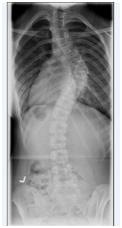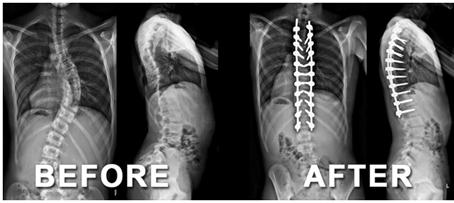About
When this curve occurs, the spine looks more like an S or a C rather than a straight line. This curve can lead to changes in one’s shoulders, ribcage, pelvis, waist, and the overall shape of one’s back.
Scoliosis affects many individuals in Canada. It is more common in girls than boys.
“Idiopathic” means of unknown cause. Idiopathic scoliosis is when the spine is curved sideways but there is no known cause of this curvature. It is believed that genetics may play a role in the development of idiopathic scoliosis. This is the most common type of scoliosis and can develop at any age.
“Congenital” means present at birth. Congenital scoliosis occurs when the bones in the spine (vertebrae) are not shaped properly (abnormality) from birth. This is the 2nd most common type of scoliosis.
Neuromuscular scoliosis is caused by a neuromuscular disease or condition (e.g. cerebral palsy, spinal muscular atrophy, and spina bifida). Neuromuscular scoliosis is also known as secondary scoliosis. This is the 3rd most common type of scoliosis.
Scoliosis is diagnosed by a physical exam followed by an X-ray. The X-ray views the vertebrae to see if they are in a straight line or curve to form the shape of an “S” or a “C”. The X-ray may also tell the size of the curve. The size of the curve is measured in degrees:
- Small curve: less than 20 degrees
- Moderate curve: between 20 and 50 degrees
- Large curve: greater than 50 degrees

There are several different ways to treat scoliosis. The type of treatment selected depends on the type and size of the curve.
Your orthopedic surgeon (bone and joint doctor) will discuss with you the possible treatment options for your scoliosis.
If you have a small curve in your spine, you will be observed over time to see if there are any changes in the curvature.
For a medium-sized curve, you may be observed over time or treated with a brace. The brace will not cure or reverse the scoliosis, but may prevent the scoliosis from getting worse. Once the brace is removed, you will be observed for a period of time.
If your curve is larger, you may require surgery. Surgery is done to improve or correct the curvature in the spine and prevent it from getting bigger.

Regardless of the treatment that you and your doctor decide, it is important to maintain a healthy lifestyle!
- Be physically active: yoga, Pilates and swimming are good activities to help develop core muscle strength.
- Eat healthy: a good diet will help your overall body health.
-
Avoid unhealthy lifestyle behaviours (e.g. smoking)
- Attend regular follow-up visits with your doctor and follow their recommendations regarding activity and lifestyle modifications
